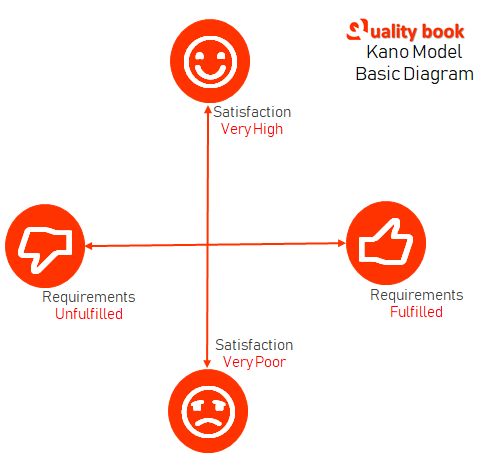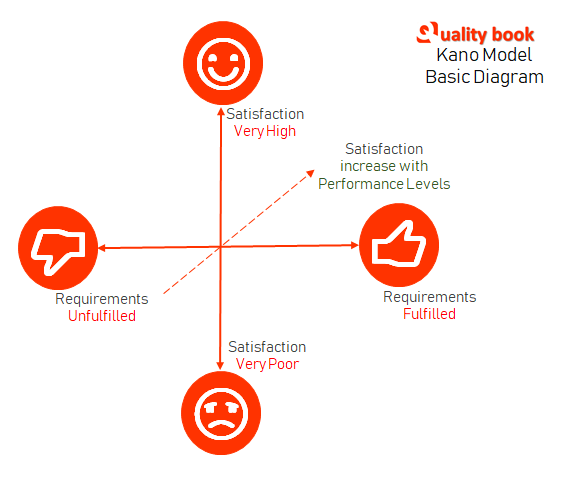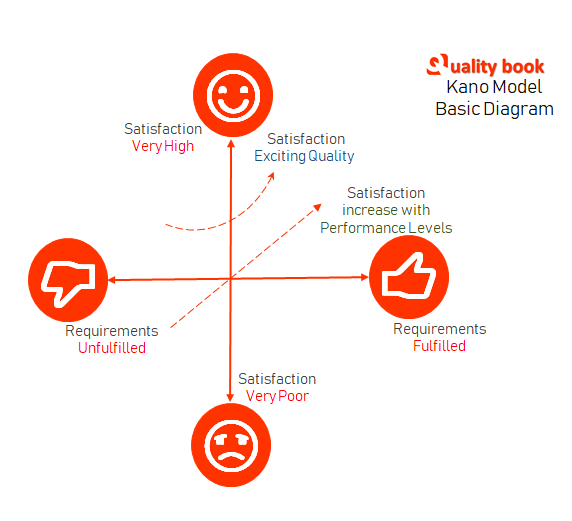What is Kano Model?
Kano Model is systematic approach to prioritize customer requirements based on understanding customer needs and value that customers place on the various features your product.
The understanding of customer requirements and satisfaction is most important in the design of products, and Kano model help you to focus design of products, that is the reason Kano model are being most popular worldwide for improvement of services related to customer satisfaction.
Kano Model Process Flow : Table
| RESEARCH | ANALYSIS | PLOTTING AND DIAGRAM | STRATEGIZE |
|---|---|---|---|
>>
| >>
| >>
| >>
|
Research:
| Analyze it..
| Prepare Diagram of the information analyze. | Planning & Act
|
Kano Model Analysis
For improvement of customer satisfaction through well-designed product and services, you should categories / classify these product attributes. The Kano model classify each attribute as on base to its impact on customer satisfaction and that will be categorized in three major types of needs are:
The Kano model help to get state answer the questions such as what does the customer requirements, customer value, expectations, and what delights the customer. But not all customer requirements are of equal importance and the Kano model helps you to prioritize and focus on feature of product which can increase to delights the customers. So, let’s see how the Kano model helps to analyze the information through divide customer requirements in categories:
Basic (Most be require)
The category represents the customer minimum criteria that must be met by product as basic requirements which often unspoken and are expect by customers. In case if they are not comply / fulfil. Customers will be highly dissatisfied and no more customers will be interesting in your products, at the same side even if these requirements are fully comply, they will not return any additional customer satisfaction beyond a neutral level.
See the picture below explain the condition:

If you comply all the things with products (according this Kano model category), “customer just neutral”, but when perform poorly, “customers highly dissatisfied”.
What mean of this? mean is The general characteristics make the product worthwhile. The basic requirements from customers or Kano Model’s initial categorize recommendation is, the attribute must be present for the customer to be satisfy. You have to determine, what are really product’s initial or feature requirements of end applications.
Performance (More is Better)
The performance attributes or One-dimensional Requirement describes that the more is better, more attribute is present in product, more satisfy the customer. Performance attributes, more is generally improving customer satisfaction, but an on absent or weak performance attribute can reduce customer satisfaction. The Kano model specify in this category, it is depending on performance levels, customer will be satisfy or dissatisfied. Satisfaction is proportional to the level of fulfilment of these attributes.

The performance attribute’s line goes through the origin at 45 degrees. it is showing the requirements that are directly associating to customer satisfaction. That is, more features and functional the product is with regard to this type of need, the more customers are satisfying.
Delighters
The third category describes that, if the requirements is not fulfill, it does not cause dissatisfaction, but it will delight customers if present. Generally, these requirements are the product criteria, or unexpected offering that delight the customer. in short fulfilling these requirements lead to more than proportional satisfaction. If they are not meet, however, there is no feeling of dissatisfaction.

The delighter curve indicates in above picture, in which the customer is more satisfied with the product is more functional. But is not dissatisfied, when the product is less functional. Therefore, even if they are not met, customers not cause any dissatisfaction. The high performance on these have a greater impact on overall satisfaction rather than low performance.
5 Steps of Kano Model Process – How to Use Kano Model?
- Customers feedback is main source of the information. The information you can collect through surveys, interview, customer complaints, competitive analysis etc. all the collect information from the customers must be capture as the voice of the customer. Research available data sources, determine data collection strategy, design data collection instruments and collect and summarize data are steps of the initial phase or first step of Kano model.
- Base on that information, identify the customer needs that are known or perceived. Analyze results from data collection, develop functional and dysfunctional questionnaire, distribute questionnaire to understand what is important to the customer – quantitative attributes as known as critical to quality characteristics.
- For each potential requirement, you can ask the customer how they would feel if product features met that need or did not meet that need. On base of feedback, you can prioritize the critical to quality characteristics as basic, performance or delighter.
- Ultimately, you can assess how well your product quality is satisfying each of these characteristics. The product development and marketing strategy depends on it.
- The Kano Analysis results can be use as input into development of product or improvement efforts. The product which is still under development, it should be immediately address basic requirements as analyze. The results help to assess the managing balance between profitability, customer satisfaction and growth.
Conclusion:
The Kano model is a theoretical model focus on customer satisfaction. Through identifying three types of requirements related to product quality and compliance. The Kano Analysis helps to understand the customer needs, expectations through collecting information, feedback and complaint. The application of the Kano model defines information in three categories. Which is help you to study and comply requirements by adding features and functionality in the product, on base of analysis.